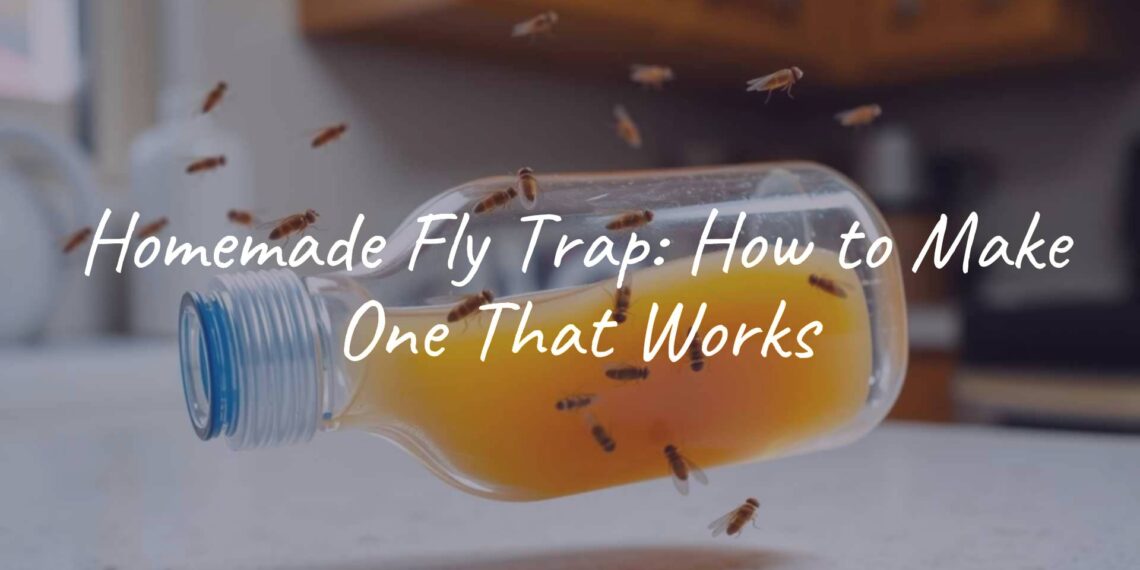A homemade fly trap is a simple DIY tool made from everyday items you probably already have at home. Its job is to attract, catch, and kill bothersome flies-whether tiny fruit flies near your produce or bigger houseflies buzzing in your kitchen. These traps use scents that flies like, such as sweet or fermenting smells, to lure them in. Once inside, the design makes it hard for flies to get out, helping you get rid of them without much hassle or expense.
What is a homemade fly trap?
A homemade fly trap is basically a practical device you put together using things like bottles, jars, or plastic wrap. These easy-to-make traps are handy because you don’t need to buy special tools or use harsh chemicals. Many people who want to save money or avoid store-bought pesticides choose them because they work, are easy to make, and are safer for the environment.
How does a homemade fly trap work?
These traps rely on the fact that flies are naturally drawn to certain smells, especially those that remind them of ripening or decaying food. The scent acts as bait. Flies fly inside, but then can’t figure out how to get back out. Most traps also have a liquid in them, usually with a few drops of dish soap. The soap breaks the liquid’s surface, so when flies land on it, they sink and can’t escape.
For example, you can use a glass jar with some apple cider vinegar and a bit of dish soap. The vinegar’s strong, sweet smell lures fruit flies in; the soap makes sure they drown. Some traps use a funnel shape that lets flies in but confuses them when they try to find their way back out. Sticky traps use glue instead of liquid to catch flies as soon as they land.
Why make a fly trap at home instead of buying one?
There are several good reasons:
- Cheaper: You don’t need to spend money on commercial traps. You can make your own for almost nothing.
- Better for the environment: Homemade traps reuse things you would throw away and skip the use of extra chemicals.
- Safe for families: If you have kids or pets, you can be less worried about them getting into unsafe chemicals.
- Quick and customizable: You can create a trap that fits your needs and adjust it as you learn what works best.
Which materials are needed for a homemade fly trap?
One of the best things about homemade fly traps is that you likely have everything you need already at home. No need for fancy supplies or tools.
Household items used in fly traps
You need two main things: a container and something to attract the flies. Good container options include glass jars (Mason jars work great), empty plastic soda bottles, or a bowl with plastic wrap on top. Containers should be easy for flies to enter but hard to escape from.
Baits that work well for flies include:
- Apple cider vinegar (most popular due to its strong, sweet smell)
- Rotting/ripe fruit (like bananas)
- Sugar water, honey, or syrup
- For outdoor use: small pieces of decaying meat such as fish or chicken
Some other items that may help include a hammer and nail (for punching holes), scissors, toothpicks for holes in plastic wrap, and paper to make a cone for certain designs.
Environmental considerations for materials
Making your own fly traps helps reduce waste since you’re using jars, bottles, or other things you’d usually throw away. The baits-such as vinegar, fruit, and sugar-break down naturally, so you aren’t adding chemicals to your home or garden. This makes homemade traps a good option for anyone wanting to avoid extra trash or chemical residue.
What are the most effective homemade fly trap designs?
While all the homemade traps follow the same idea, there are several popular designs, each with its own benefits. Here are some of the best:
1. Mason jar fly trap
- Use a clean Mason jar with a lid.
- Make several small holes in the lid with a hammer and nail.
- Add 1/4 cup apple cider vinegar and a few drops of dish soap.
- Screw on the lid and set the trap where you see flies. The holes let flies in but keep them from getting out, and the lid helps prevent spills.
2. Soda bottle fly trap
- Cut an empty plastic bottle in half across the middle.
- Put bait (like vinegar, dish soap, and maybe a piece of fruit) in the bottom half.
- Flip the top half upside down and place it into the bottom half, creating a funnel shape.
- Flies go in but rarely come back out due to the funnel’s shape.
3. Plastic wrap-topped jar
- Put bait in any jar.
- Cover tightly with plastic wrap and secure it with a rubber band.
- Poke a few holes in the plastic wrap-flies enter but often stay trapped.
4. Paper cone in a jar
- Fill a jar with bait (vinegar, ripe fruit, dish soap).
- Roll a piece of paper into a cone and place it so the narrow end points down toward the bait.
- The cone directs flies in, but makes it tricky for them to leave.
5. Sticky flypaper and bucket traps
- Wrap sticky flypaper around a bucket, or set up several large sticky strips near problem areas.
- Great for large spaces like barns or outdoors.
What bait works best for attracting flies?
The right bait is key to making any trap work. Flies like sweet, rotting, or fermenting things.
Fruit-based baits: Which fruits are most effective?
Fruit flies are especially drawn to overripe or rotting fruits. Good choices:
- Bananas (work the fastest)
- Peaches
- Apples
- Tomatoes
Using a piece of overripe fruit in your trap can make it even better at catching flies.
Vinegar, sugar, and other alternative baits
- Apple cider vinegar is the top choice for fruit flies due to its strong, sweet, fermented smell.
- Always add a few drops of liquid dish soap-this keeps flies from escaping by sinking them when they land in the liquid.
- Other liquid baits: sugar water, honey, or syrup.
- For houseflies, try using scraps of rotting meat plus sugar or honey if you’re setting a trap outside.
Why do some baits fail?
- Bait isn’t strong enough, or it’s not right for the type of fly.
- Bait gets old and dries out, losing its scent.
- The trap’s design might let flies escape, even if the bait is good.
- Nearby sources of food (like open garbage) are more tempting than your trap.
- Replace baits every few days and place traps where flies are most active for the best results.
How to build and set up a homemade fly trap
Building a homemade fly trap is quick. The real trick is putting it in the right place and keeping it working.
Step-by-step instructions for common traps
Mason Jar Trap with Holes in the Lid:
- Get a clean Mason jar, a lid, apple cider vinegar, dish soap, a hammer, and a small nail.
- Pour about 1/4 cup of vinegar and two or three drops of dish soap in the jar.
- Poke 6-8 small holes in the jar lid with the nail and hammer.
- Screw the lid on and put the jar where you see flies.
Soda Bottle Funnel Trap:
- Take a clean plastic soda or water bottle and scissors.
- Cut the bottle in half just above the label.
- Add bait to the bottom half (vinegar with dish soap, maybe some ripe fruit).
- Turn the top half upside down, neck facing down, and place it inside the bottom half. Secure with tape if needed.
- Set trap where flies are a problem.
Placement tips for maximum fly capture
The best spots for your fly trap:
- Near fruit bowls or fresh produce
- By houseplants (if gnats are a problem)
- On windowsills, since flies go toward the light
- Close to indoor trash cans or compost bins
- Outdoors: By compost, pet waste, or animal pens
Place outdoor traps a little ways from doors or places where people gather, so you draw flies away from living areas.
Maintenance and cleaning recommendations
Check your fly traps every few days, and at least once a week. If you notice a lot of dead flies or if the bait is dried out or not smelling as strong, it’s time to clean and refill.
- Unscrew lids or take apart traps.
- Dump the fly-filled liquid down the drain with water, or put it in a sealed bag and throw in the garbage.
- Wash the container in hot, soapy water.
- Refill with fresh bait and set the trap up again.
How effective are homemade fly traps compared to store-bought solutions?
Many people wonder if homemade traps work as well as ones from the store. While store-bought traps may be fast and easy, homemade traps have their own strong points.
Benefits and limitations of homemade traps
Benefits:
- Low Cost: You’re using things you already have, so you spend little to no money.
- Safe Ingredients: Natural baits are safer for kids, pets, and anyone sensitive to chemicals.
- Less Waste: Reusing jars and bottles means less garbage.
- Quick Solution: You can make a trap right when you need it, without an extra shopping trip.
- Works Well: Some homemade traps, especially the Mason jar type, can catch a lot of flies.
Limitations:
- Most are best for fruit flies and gnats, not big houseflies (unless you switch to meat-based bait).
- Not very attractive-clear jars with floating flies don’t look great in the kitchen.
- Need to be cleaned and refilled often.
- Some assembly required.
- Might not solve large-scale infestations on their own.
Cost comparison with commercial fly traps
| Type | Estimated Cost | Notes |
|---|---|---|
| Homemade Trap (jar & vinegar) | Under $1 per use | Nearly free after first setup |
| Sticky Trap (store-bought) | $2-$5 each | Needs replacement regularly |
| Decorative Traps/Outdoor Bags | $10-$25 each | Reusable, but higher upfront cost |
Overall, homemade traps save money, especially if you have a frequent fly problem.
What safety and health precautions should you follow?
Homemade traps are usually safe, but you should still follow a few basic steps to keep everyone healthy and your house clean.
Are homemade fly traps safe for pets and children?
Because homemade traps use natural bait, they are much safer than chemical-filled ones. Still, keep traps out of the reach of young children or pets to avoid spills or the risk of broken glass. Put traps up high, inside cabinets, or in spots where curious hands or paws can’t reach. If using something strong-smelling like rotting meat, only do so outside and out of reach of animals.
How to dispose of trapped flies hygienically
- Pour used bait and dead flies down the drain, flushing with lots of water to prevent clogs and odors.
- Or, seal them in a plastic bag and put them out with the trash.
- Wash traps with hot, soapy water after each emptying to keep things clean and fresh.
Regular cleaning and safe disposal keep pests away and your home smelling good. By following these easy steps, you can control flies at home safely, cheaply, and with less impact on the environment.
















![What to with Scrap Metal? [infographic]?](https://facts-homes.com/wp-content/uploads/2019/07/645413-POPYOV-391-120x86.jpg)





